- INTRODUCTION
- LECTURES
- A_Mart Kalm / Modernism In Estonia: From Industrialist’s Villa To Kolkhoz Centre
- B_David Crowley / The Fate of the Last Generation of Ultra-Modernist Buildings in Eastern Europe Under Communist Rule
- C_ Claes Caldenby / Urban Modernity. Nordic-Baltic Experiences
- D_Marija Drėmaitė And Vaidas Petrulis / Modernism In Soviet Lithuania: The Rise And Fall Of Utopia
- E_Anna Bronovitskaya / Glimpses Of Today In Visions Of Russian Avant-Garde Architects
- ESSAYS
- Ernestas Parulskis / Commemorative Plaques In Lazdynai
- Indrė Ruseckaitė and Lada Markejevaitė / Elena Nijolė Bučiūtė’s Personal Modernism
- Maija Rudovska / In The Shadows Of Nostalgia. Marta Staņa’s Legacy In Latvia
- Liina Jänes / Position Of The “Other”: The Architecture Of Valve Pormeister
- Julija Reklaitė / Amber Inclusions. What Modernist Memorabilia Can Tell Us
- INTERVIEWS
- Talking About the Richer Picture. An Interview with David Crowley by Aistė Galaunytė
- An Active Archive For A Public Discussion. An Interview with Hartmut Frank by Eglė Juocevičiūtė
- Cheating The Space Or Cheating The Time. An Interview with Frédéric Chaubin by Eglė Juocevičiūtė
- More Freedom, More Privacy. An Interview with Anna Bronovitskaya by Eglė Juocevičiūtė
- Sinchronicity of Ideas. An Interview with Andres Kurg by Eglė Juocevičiūtė
- Recycling Socialism. An Interview with Aet Ader by Viktorija Šiaulytė
- ABOUT
Mart Kalm during the lecture, photo by N. Tukaj
Good evening. I am glad to be here and it has been a great honour for me to be invited. The curators asked me to choose a book and I see that many of the colleagues have not chosen their own book. However, I have chosen my own book, in which I wrote about Estonian architecture, this particular book was published around ten years ago and it represents the first twenty-five years of my work in Estonia. Of course it is possible to go deeper in some areas, but the majority of the best things are covered. It doesn’t necessarily pose a problem for others, but it does for me as to what I should do next. The younger art historians have been critical saying that I have tried to establish a kind of canon. This is true, it does represent some kind of canon, but in a way this was unavoidable. Also, I represent Estonian architecture by a great narrative, it is also true that it grew out of my course at the Estonian Academy of Arts, which by now I have read more than twenty years already. It is the history of Estonian modern architecture and the book is a survey of it. But also in a Post-Communist context it was necessary to write a book which gave a kind of “pedigree” to the Estonian architects. It would be stupid if each generation started the discovery of the bicycle again and again and they weren’t aware of what their fathers and grandfathers had done before them. This book is not written as a stylistic history, it combines social and political aspects, typologies, architects’ personalities but also within the book the style history has not been totally forgotten. It mixes more or less all contemporary approaches that one could have to architecture. That is why I thought for my talk maybe it makes sense to have an alternative or partly alternative view to Estonian architecture.
I thought that because you have here ideologies already mentioned in the title of these series of lectures, I have chosen partly to draw parallels to what happened in Lithuania or at least how much I know about it. My second task today is to show that there has been a kind of continuation from the pre-war modernism to the Soviet modernism. I do not know how political your writing of history is here in Lithuania, but I am afraid it may be as nationalist as it is quite often in Estonia. They try to show that the Soviet period was so terrible and there has been no continuation. Of course there was a break, that is true, but there are a lot of continuing trends as well. The third important thing is the similarities and differences in the social responsibility of architecture. The social systems of the countries such as Estonia and Lithuania in the pre-war period were not so well developed. And the fourth thing that I am going to demonstrate is the question of materials and so I have tried to linger between these four layers.
The modernism of Western Europe was very socially conscious. The majority of the avant-garde architects of the 1920s in Western Europe were left-wing semi-communists. It is hard to imagine a similar situation in the Baltic countries, where modernism was much more often understood as a fashion that should also be followed. The modernism we had in the Baltics was not so social – of course, we had some cooperative housing in each of the countries, but it was never so socially conscious and it was the industrialist’s villa that was much more characteristic to the early modernism.
Of course, these semi-communist architects in Western Europe always dreamed of the happy future of the working class, but in reality the best commissions they received in which to realize their ideas were from the industrialists, for whom they built villas. This is kind of a paradox. There is a canon of the best Estonian architects and the best functionalist villas in Estonia. You can see them while browsing the book, but I am not going to show these – I wanted to have a kind of alternative to my own canon.
I have consciously chosen a second or third rate architect via whom I want to convey the story. In the 1930s, Eugen Sacharias (1906-2002) was probably one of the most successful commercial architects in Tallinn. He built the majority, approximately one third, of tenement houses in the centre of Tallinn in the 1930s. It is hard to say what his origin was as the name is unsure. He graduated in the early 1920s from Tallinn Russian high school, then continued in the German speaking technical university in Prague and eventually returned to Tallinn. He was probably by blood a mixture of German, Jewish, Russian, and French. But in 1940, when most of the Estonian state was almost over and the Russians were coming in, he estonized his name from Sacharias to Saarelinn. Because Estonians had mainly German names until the 1930s, then the names were “estonized” during the nationalist regime. Therefore, he went through the same process as Estonians, despite the fact that he was not Estonian by blood. He then immigrated to Australia.
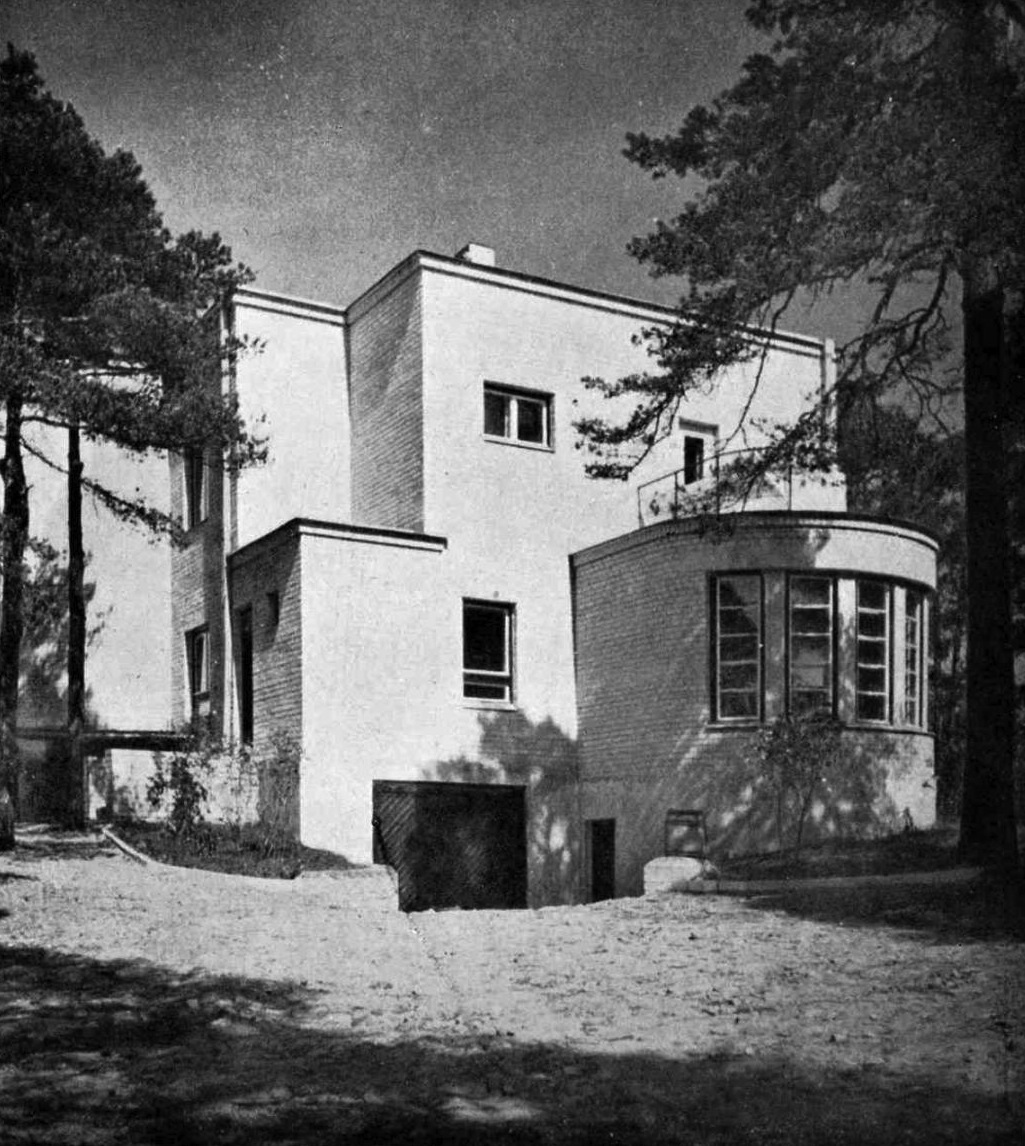 Villa for industrialist Bruno Kadak, architect Eugen Sacharias, Rutu 3, Tallinn-Nõmme, 1933 – 34 and contemporary pictures by Mart Kalm
Villa for industrialist Bruno Kadak, architect Eugen Sacharias, Rutu 3, Tallinn-Nõmme, 1933 – 34 and contemporary pictures by Mart Kalm

 Villa for industrialist Bruno Kadak, architect Eugen Sacharias, Rutu 3, Tallinn-Nõmme, 1933 – 34 and contemporary pictures by Mart Kalm
Villa for industrialist Bruno Kadak, architect Eugen Sacharias, Rutu 3, Tallinn-Nõmme, 1933 – 34 and contemporary pictures by Mart Kalm
One of his villas is in Nõmme, a Tallinn suburb. He built himself a similar villa, but here you see a pre-war picture and a contemporary picture of a silicate brick villa he designed for a silicate brick industry owner Bruno Kadak. In the contemporary picture it has changed slightly, there were some annexes added to it in the Soviet period, and the balcony has changed to a veranda. In 1940 the house was nationalized and as usually happened to the biggest villas – a kindergarten was made inside. To my mind, the positive side of the story is that the Kadak family survived, via Siberia of course, but they still live in Estonia and the houses have been returned to the family. The son of Bruno Kadak still lives there and they have the next villa where their sister lives. So they have their property back.
But it is interesting that the building is built out of these silicate bricks, which is a specific artificial stone. The technology to make silicate brick was invented in Germany in the late 19th century and in Nõmme this silicate brick factory started in 1910. It is made of limestone and sand and then put together and then put into an autoclave. The silicate brick is not beautiful; it is rather pale or light grey.
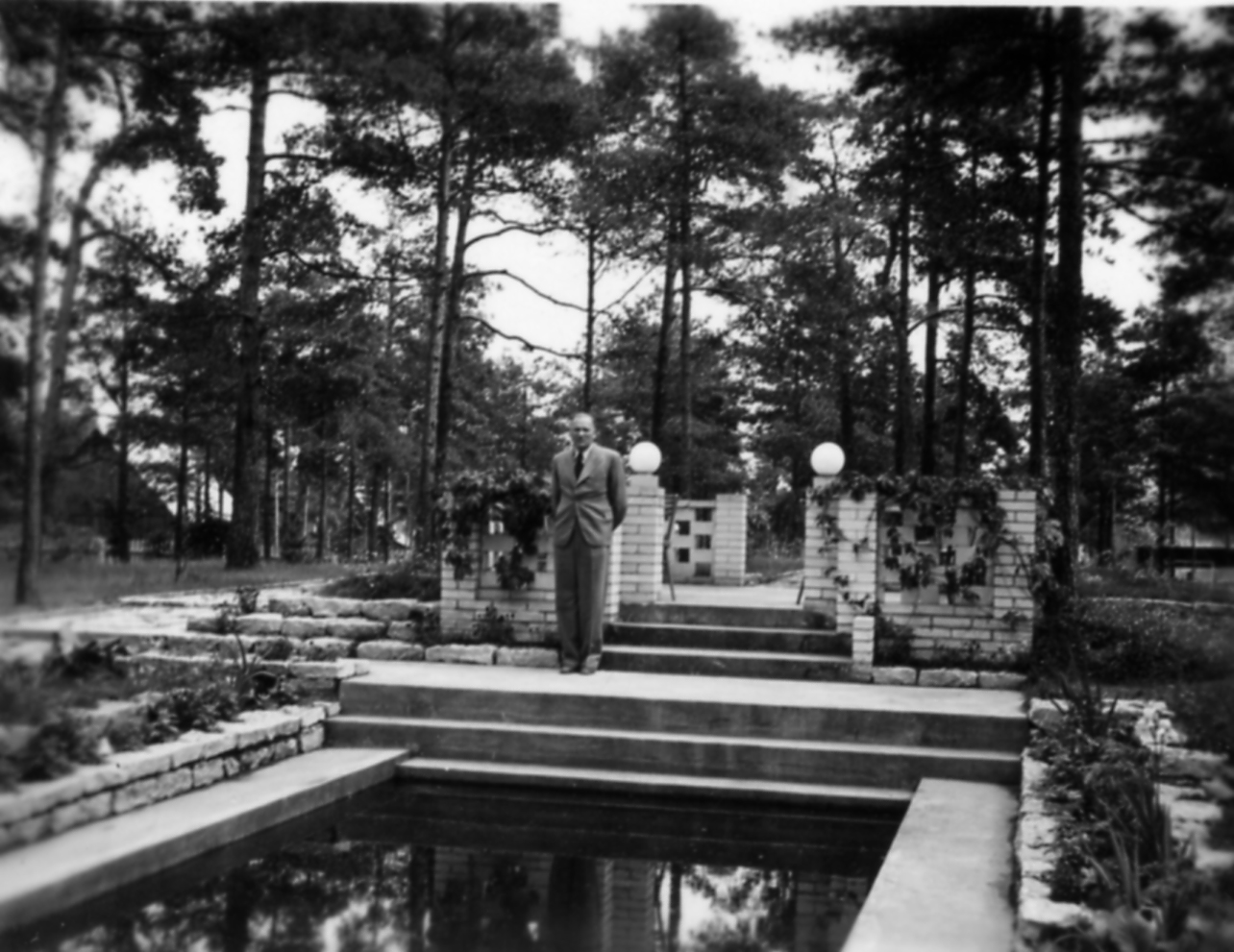 The pool at the Bruno Kadak’s villa, architect Eugen Sacharias, 1933 – 34
The pool at the Bruno Kadak’s villa, architect Eugen Sacharias, 1933 – 34
If you do not plaster it, you follow the ideology of pure materials – according to the classical traditional architecture it should be blocks of real stone, like you have in the chateaux in the outskirts of Paris. However, it is too expensive and this honesty of materials is not a bad idea. If you build it correctly and use other devices – architects should be inventive – it is not so bad.
The modernism of the 1930s, even in this bourgeois form that we follow here in the case of a villa, also included all the important ideas of modernism. Next to the material, the other important thing is healthy living conditions – you must have huge windows, but also you are in a pine forest and so you use more or less modernist gardening: the pool, the terraces. In Tallinn one has this lime stone terraces; it fits so well with functionalist architecture.
Regarding the interiors, the traditional history of architecture tries to find in these peripheral countries like Estonia the purest of modernist examples. But these were only exceptional cases and not a normal paradigm. Much more usual were Art Deco interiors. If these were professionally done, they showed the story behind these villas much better. It is absolutely clear that the rich industrialists in Estonia did not want to have laboratory-like interiors. They needed an interior which was modern, functional, easy to keep, and beautiful, and beautiful meant traditional decorations. They had to show how rich they were via their house. The house was a representation of the personality and if one does it as in Stuttgart-Weissenhof (pure modernism), one cannot show it and that is why some of the decorations were needed.
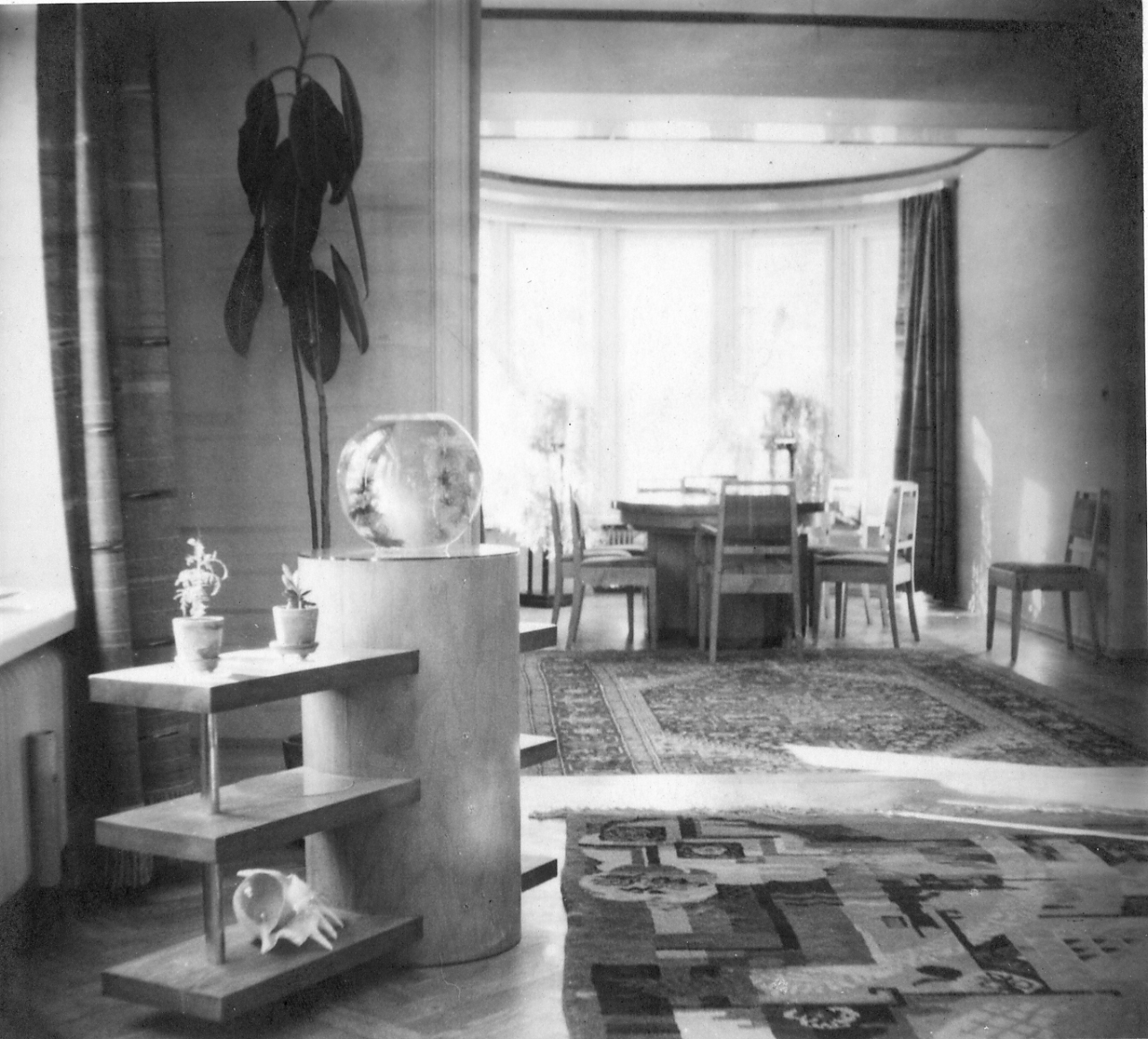
 Interiors of Bruno Kadak’s villa: dining room and living room, 1933-34
Interiors of Bruno Kadak’s villa: dining room and living room, 1933-34
The main rooms of Bruno Kadak villa, the study and the dining area, are decorated with lamps and étagère, and they are not ‘proper’ modernism. It is the Art Deco modernism which is much more suitable for a normal bourgeois family and for a commercial architect who was not an avant-gardist. There are similar examples of Art Deco villas in the countries famous for their avant-garde buildings. To my mind, for emphasizing the conservative and undeveloped social relations in Estonia this Art Deco villa of an industrialist is a good example in showing the real position modernism had in Estonia.
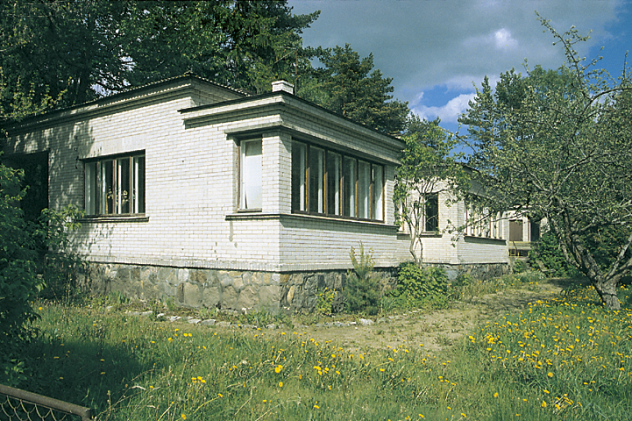 Engineers’ apartments, Lehtse Peat Industry, engineer Dmitri Tenisberg, 1936. Photo: Mart Kalm
Engineers’ apartments, Lehtse Peat Industry, engineer Dmitri Tenisberg, 1936. Photo: Mart Kalm
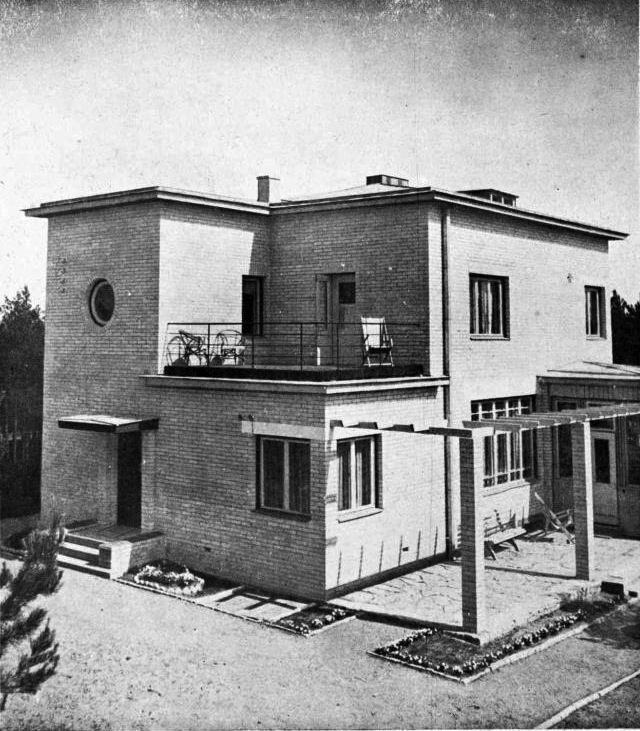 Villa in Pärnu street 176, Tallinn-Nõmme, architect Eugen Sacharias, 1936
Villa in Pärnu street 176, Tallinn-Nõmme, architect Eugen Sacharias, 1936
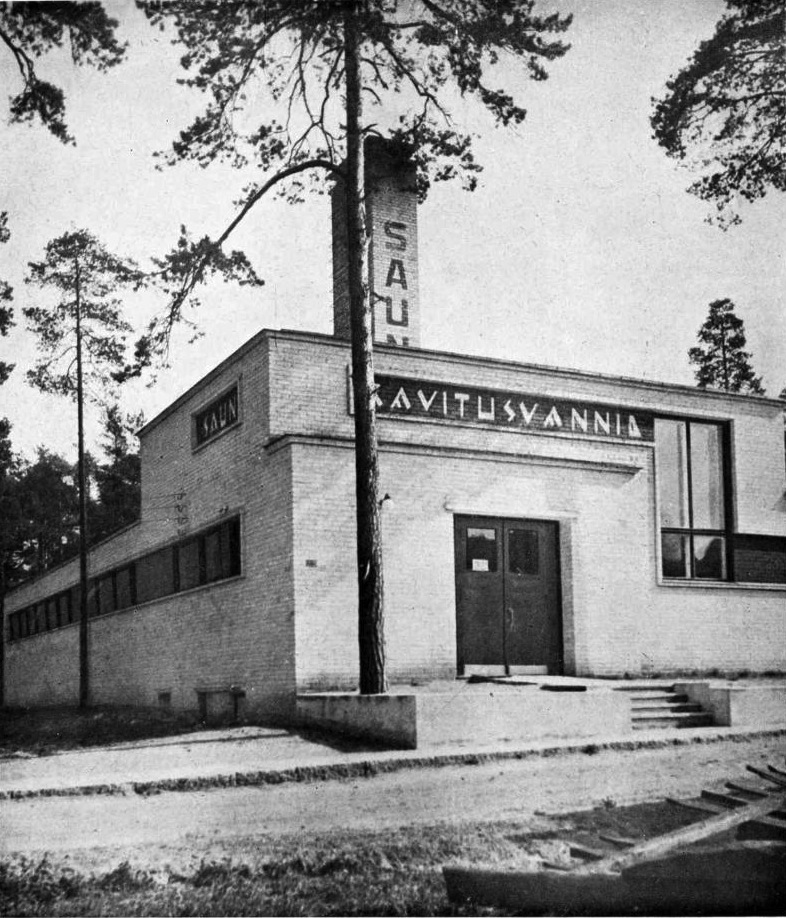 Sauna cum spa in Valdeku street, Tallinn-Nõmme, architect Robert Natus, 1931
Sauna cum spa in Valdeku street, Tallinn-Nõmme, architect Robert Natus, 1931
This pure non-plastered brick architecture was widespread in Estonia. There was one more villa designed by Sacharias for Kadak’s cousins – an engineer’s house in Peat Industries of Estonia, also a villa in the Nõmme area by the Baltic-German architect Rober Natus, a sauna building which was completely rebuilt and plastered ten years before and had lost its original outlook, and finally among all these examples of silicate brick in the architecture of the 1930s – the observation tower on Suur-Munamagi hill.
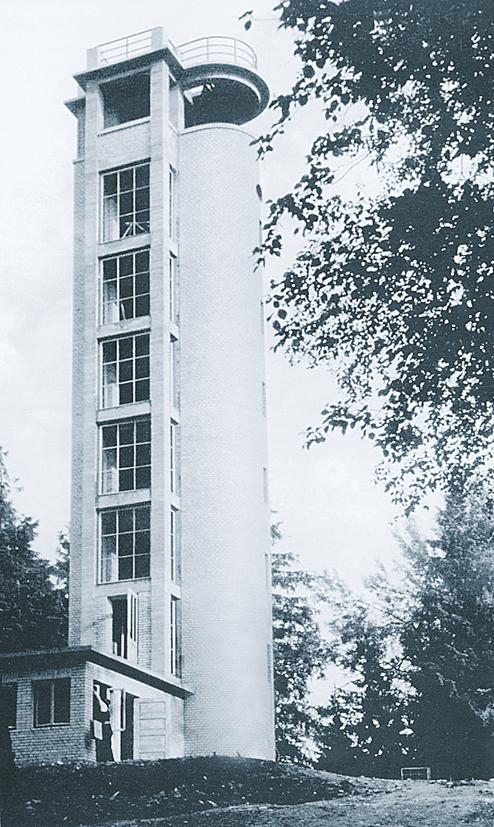 Observation tower on Suur-Munamägi Hill, Võru county, architect Artur Jürvetson, 1939. Estonian Museum of Architecture
Observation tower on Suur-Munamägi Hill, Võru county, architect Artur Jürvetson, 1939. Estonian Museum of Architecture
But the 1930s was the period of huge modernization and one of the new characteristic features was that bus transport had become common. This meant also that school excursions started. The school children in Estonia needed places where they could go for a class excursion by bus. All the monuments that we had in Estonia were wrong. We had a different history in this sense. All the castles were built by Teutonic knights – German, and all the beautiful manor houses were built by Germans for Germans because the Estonians had been just peasants. There was a need for new Estonian monuments and the observation tower on the highest peak – nothing could be better to fit this purpose.
I want to return to the social issues. The villa from Kadriorg shows that even if a lot of houses were built from silicate bricks, usually if one had more money and if one was not a silicate brick provider, one would have preferred to plaster the building.
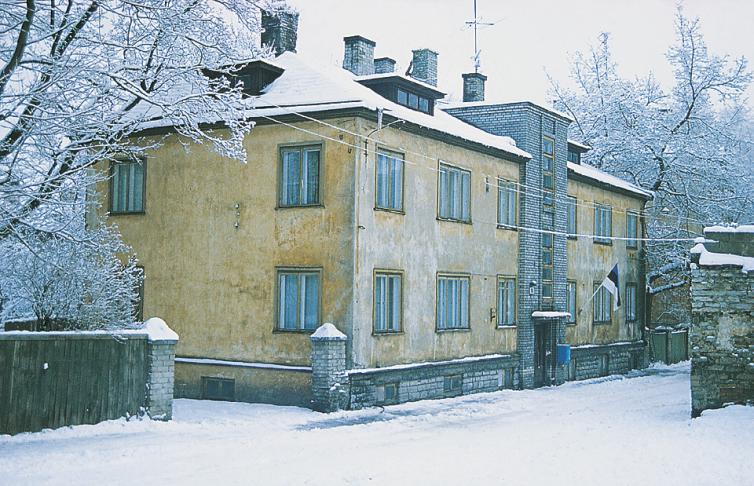 Quasi-modernist mass housing of the 1930s in Tallinn. Photo: Mart Kalm
Quasi-modernist mass housing of the 1930s in Tallinn. Photo: Mart Kalm
In Tallinn silicate brick was also used in wooden houses for the staircases. The staircases were made of silicate brick, but the house was not a stone building – it was wooden and plastered. I don’t know if the same thing happened in Lithuania, but in Scandinavia and Nordic countries it was typical in the 1930s as wood was the cheapest material to build, it being plentiful, but the new fashion was plastered, light, smooth surfaces and so the wooden houses were plastered. We call it the Tallinn type house. The reason why the wooden houses had this silicate brick staircase in the centre was hidden in Tallinn construction decrees, which laid down that if a homeowner had a wooden house they had to have, for fire regulations, two wooden staircases or one in stone, and I believe this was a very old rule from the 1890s, which was put in practice only during WWI. This was the most popular house type in the late 1920s and early 1930s. During the economic crisis, a lot of existing money was put into construction and in the Tallinn suburbs this Tallinn type of wooden houses with silicate brick staircases really boomed.
The continuation of modernism from bourgeois pre-war independent Estonia to the postwar Soviet socialist republic of Estonia was with a kind of interludium because a coup d’etat had happened in Estonia in 1934; the coup d’etat was led by the leading politician Konstantin Päts, who later became the president. He had naïve architectural ideals; he believed the building should be beautiful and decorated as can be seen in his office in Tallinn-Kadriorg.

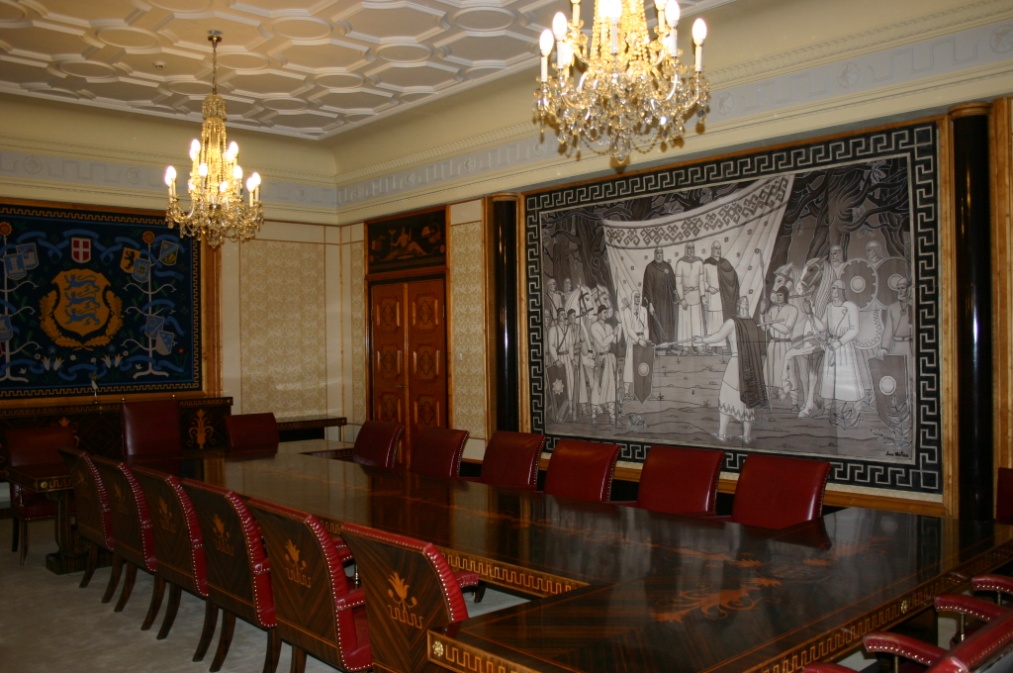 Exterior and interior of the President‘s Office, Tallinn-Kadriorg, architect Alar Kotli, 1937 – 38
Exterior and interior of the President‘s Office, Tallinn-Kadriorg, architect Alar Kotli, 1937 – 38
It was so that the Baroque palace in Tallinn-Kadriorg was a Russian tsar’s summer residence built by Peter the Great immediately after Estonia had been conquered by Russia, it was designed by the Italian architect Niccolo Michetti. When Tsarist Russia collapsed, the Estonian parliament didn’t know what to do with the tsar’s summer residence and subsequently there was a lot of discussion. One option was a museum but Estonian museums were not a reliable institution at that time. The state took it over and placed there the head of the government as a state residence and the new chancellery building was built behind it. The building survived the Soviet regime well and of course in Kadriorg palace there is now an art museum like there was in the Soviet times and the Estonian president lives here nowadays. The current Estonian president’s official residence is in the pre-war head of the chancellery plus a driver’s apartments and two apartments put together. It’s not beautiful to be honest, but at the same time I like that if we are in our independency again, the beginners can’t be too representative, so in this sense I like the situation.
Of course all the later presidents had more ambitions to have much bigger residences, but it is thanks to our parliament who has never given enough money to the president to have this luxury.
The chancellery was designed by architect Alar Kotli, who had studied in Danzig or Gdansk in the 1920’s. In the early 30’s he designed several functionalist buildings, then served as President in the end of 1930’s with this style which I have called representative traditionalism. He continued after the war with the same manner. You may say: ok, it’s the first example of Stalinist architecture in Estonia, but this early Stalinism was done by pre-war decorations in hand for those architects. But as we are talking about modernism, I won’t stop at this juncture I’ll just mention it. By the mid 50’s Stalinism was over and the same Alar Kotli, who had done for pre-war President Päts and then for the Stalin regime, he was capable in the mid 50’s of designing an absolutely modern building – the Song Festival Arena in Tallinn (1957-1960). And this is surprising because the majority of the pre-war architects were so beaten, so shaken by the Soviet regime that they were not capable of recovering anymore. Kotli was the only one who really made something creative and inventive after Stalinism in the 50’s. But he died early. He was less than sixty when he died in 1963. He also became the head of a department of the Architecture in Art Academy (the Art Institute as it was called then).
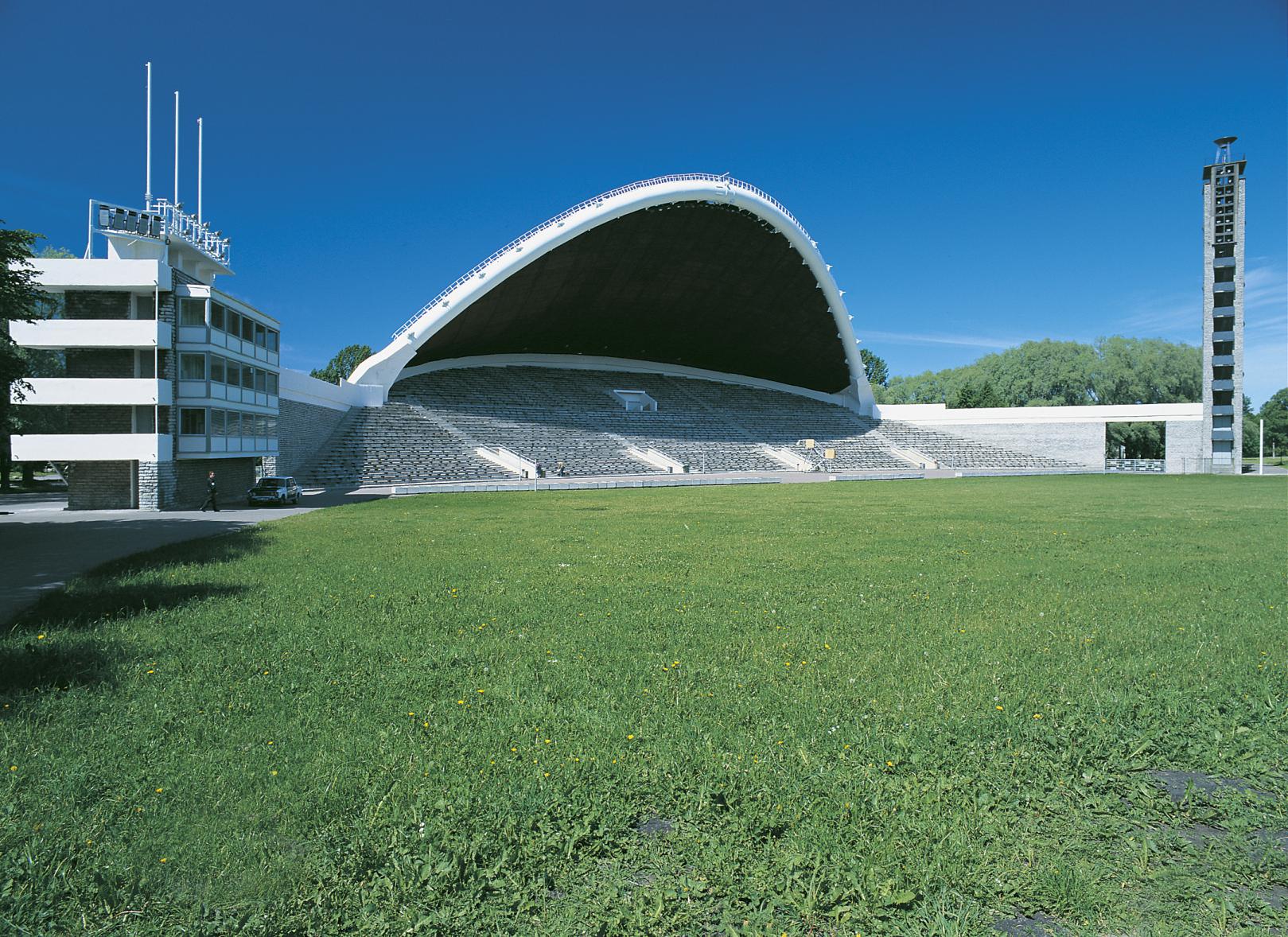 Song Festival Arena, Tallinn, architect Alar Kotli, 1957 – 60. Photo: Mart Kalm
Song Festival Arena, Tallinn, architect Alar Kotli, 1957 – 60. Photo: Mart Kalm

Song Festival Arena, Tallinn, 1957 – 60. Photo: Estonian Museum of Architecture
The Arena is really surprising. It was meant for choir music, absolutely traditional folk, ok – semi-folk culture, because if you have a quantity of 30000 singers then you don’t expect that in Estonia we have 30 thousand professional choir singers. No, then it is a folk habit. And you have the most futurist architecture in the period. How can these two things be put together, in that you design for the partly folk culture and the absolutely futuristic architecture of the period? This is the interesting part. Of course among the communist party leaders in Estonia, who were not very great guys intellectually, there were some really bright Estonian communists but they mainly left for Soviet Russia and they were repressed there by Stalin in the 30’s. So all these postwar nomenklatura were rather secondary Russians. So for them it was just a symbol of the friendship of the Soviet nations and in 1960 they celebrated the 20th anniversary of Soviet Estonia with this building. And they knew that now the buildings must be modernist like in Western countries, so there were no political obstacles to this.
How did Alar Kotli get to know about such new constructive possibilities? Because the building is clearly derived from one of the American examples by Polish emigré architect Matthew Nowicki, almost the same age as Kotli. Nowicki designed a kind of tensile architecture for an exhibition hall which was completed in 1952. To be honest, nowadays it sounds funny but it was also a kind of old-fashioned task like the one’s here too, it was made for…I don’t even know how it is in English. They had fairs for breeded cows and for animal exhibitions. Kotli didn’t copy Matthew Nowicki’s idea properly. There is in Europe an absolute copy which is in Bratislava. The Bratislava ice hockey stadium is a copy of Nowicki’s American arena. But Alar Kotli didn’t support both of the arches from the ground. Only the back is supported, but the front arch is raised. And he used the inner surface of the roof as an acoustic screen. There is also a kind of comic paradox; not really a paradox, but a tragedy, even tragicomic aspect in that there was a creative idea that the voices of all those 30000 singers will be amplified by this acoustic screen. But after the first song festival electric power systems arrived and nobody needed this natural acoustic screen for the sound anymore. So nowadays they have all rock concerts there and nobody needs this extraordinary architecture, because they always have their own equipment. So, innovative architecture in this sense is useless.
Anyway, it’s interesting that in the mid 50’s an architect, who had been for 20 years a traditionalist, was capable of returning to modernism. One of the reasons or the way in which they started getting that information as to what, for example, Nowicki had done, was the library of the Academy of Sciences, which after Stalin’s death from 1954 started subscribing to Western architectural magazines (like L’architecture d’aujourd’hui, Baumeister), and all the Scandinavian magazines that were then very important. And these pre-war architects who were mainly German speaking sat late evenings amazed at what they had missed, what had been done while they had been behind the Iron Curtain. And in my mind it is a good sign that Alar Kotli was capable of recovering and of catching up with the West as Khrushchev had laid down the task and this by only looking at magazines, without the ability to travel. Kotli’s widow told me in the late 80’s that there was a proposal to Alar to visit the Brussels World Fair in 1958 in the Soviet delegation, but Alar Kotli refused because the proposal was accompanied by another proposal: to be a spy for the KGB.
Here in Vilnius you also have this Alar Kotli design, redesigned by Rimantas Alekna, which then in the 1960s had lot of passions around this fact, and in Estonia the community of architects was rather upset. Can you imagine that Lithuanians copied our unique building? And this was the general opinion.
But if we put it in the context of Khrushchevian standard design and industrial building methods, real Soviet modernism, it was absolutely natural that a song festival arena, despite the fact that it is very specific, was not taken as a unique building. Probably the only problem for Latvia was that in Riga the Stalinist wooden arena was in too a good shape to replace it with a new one. And the final result is that all our three song festivals are on the UNESCO Intangible world heritage list together. So why not to use the similar architectonics for them?
Now I reach a more peculiar aspect of the Soviet modernism. In my mind it is not interesting to tell the same story that you can tell about the prefabricated housing. I could talk about Mustamäe, you could talk about Lazdynai; we know these stories which are totally similar. But the modernist architecture for the collective farms is only partially similar. We both have these collective farms that were hated by people in the countryside: nobody wanted to give their cows to the collective farm. But during the 1960s, 1970s, and 1980s people got used to it because there was no other option. I don’t about the history of agriculture in Lithuania but in Estonia in the 1950s life in the countryside was really depressed and catastrophic: no money and the only things that one produced were for survival. But starting from the 1960s the collective farms started to rise up. In Khrushchev time there were several reforms that improved the economic situation significantly and in Estonia they started to build. By the 70s and 80s I would say that the collective farm in Estonia was probably one of the most successful pockets in Soviet Estonian society. The salaries in the 70s in collective farms were much higher than those in the cities. If in the cities people waited to get an apartment, in collective farms you got them freely. It was impossible to get permission to buy a car in the city, but in the collective farms whoever wanted one - got one. I remember how my mother wanted to get a voucher to go to East Germany. The trade union didn’t give it to her, they gave it to another lady. But in collective farms they got free vouchers to Cuba or to Northern Korea, or just holidays in Varna. It would be too much to say that collective farms were a kind of wonder in the Soviet Union but in Estonia it was an interestingly successful area.
One of the reasons for the economic wealth of collective farms was the task of the Soviet Estonian agriculture to feed the Leningradskaya Oblast (Leningrad, now St Petersburg, the city and the county). Estonia has a population of 1.5 million people and Leningrad together with the county has 4 million people. So our agriculture’s task was to feed these 5.5 million people. And they succeeded in this. And if they exceeded the quotas, in reward they got better fertilizers, Czech and Polish machinery, etc. In the 1970s and even more in the 1980s they did a lot of business with Russia.
I have a theory that Estonian agriculture in the Soviet period was quite an oasis because everybody knows that it is an oasis if you have a guaranteed bottomless market that buys everything that you can ever produce. And that’s why they made big money and with this big money they built a lot. The majority of the best avant-garde architecture of the 1970s was built for the collective farms. The famous Estonian ‘avantgardists’ like Vilen Künnapu or Toomas Rein don’t like it if architecture historians call them collective farm architects, because they want to politically neutralize the origin. They say: ‘it is a community centre for this village’, but they don’t want to say that it was built for the Lenin kolkhoz. Here their memories are very selective.
The reason why the best architecture in the 1970s and 80s was designed in the collective farms was that the big state design institutes were mainly formed by the older generation architects who had lost their innovativeness. And those 1960s and 1970s young architects went to the Kolkhoz project design institute called "EKE Projekt", where they formed a cooperative design office; they had better conditions, higher salaries, more freedom than in the state offices. And that’s also one reason why better architects met at collective farms. A couple of years ago, I made, with the students of Estonian Art academy, a summer course on collective farm architecture and we took one former "rayon" (nowadays we don’t call it "rayon", this was Soviet terminology), and the students filled in the "Docomomo" dossiers of the buildings and it was for me a very important source of information in which I got to know about this architecture, which was not represented in the magazines and what the architects wanted to show.
One of the surprises was how much in the 1960s in Estonia the Lithuanian standard designs were used. Of course, collective farms were quite often designed in a most beautiful way but the local men built it and they did the best they could.
Here is a kind of genealogy of the design that it was started like in pre-war houses in the German traditionalism, then again the silicate brick, which was very popular for the Khrushchev period architecture, and really ‘existenz minimum’ flats that were absolutely not suitable for living in the countryside.

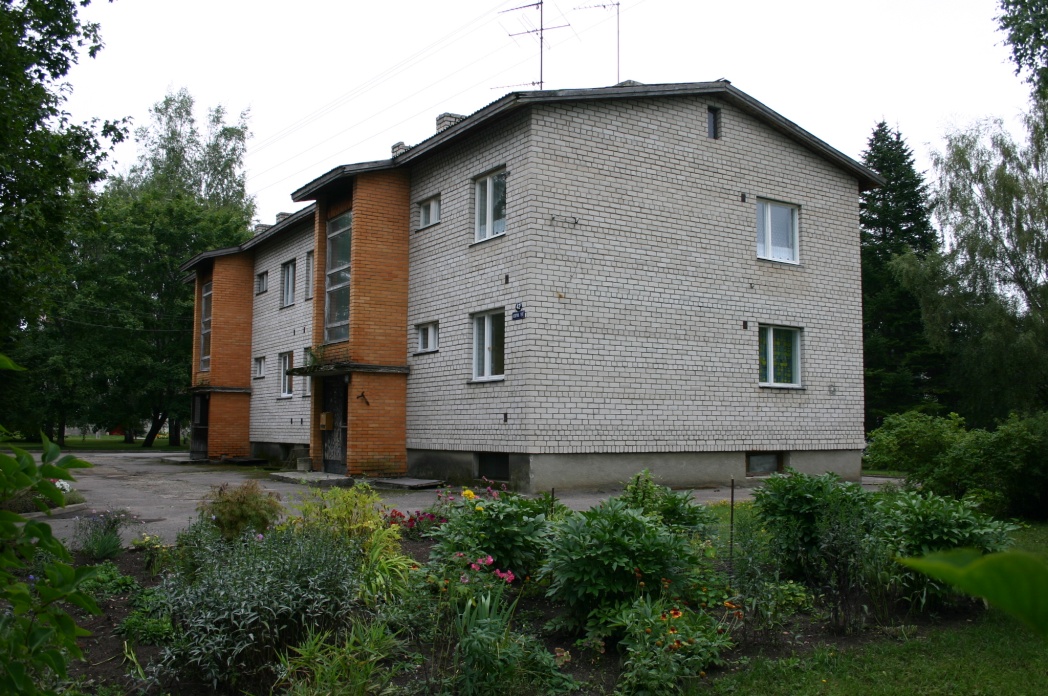
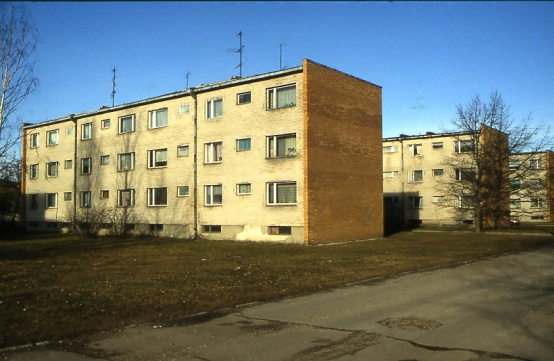
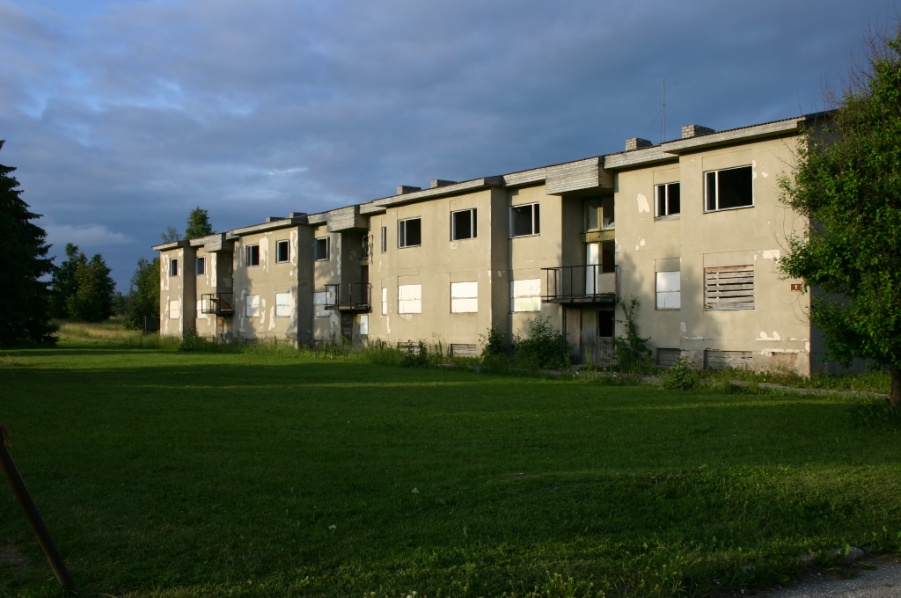 Housing in collective farms from the late 1950s; early 1960s; late 1960s; and early 1980s. Photos: Mart Kalm
Housing in collective farms from the late 1950s; early 1960s; late 1960s; and early 1980s. Photos: Mart Kalm
And again the social aspects are important – the majority of the workers of a collective farm lived it these “panelkas”. The flats were not so bad, but the ideal was a one family house for the elite of the collective farm. Let’s say one hundred flats in big apartment blocks and six one family houses: rather nice ones. So, who usually lived there? The social segregation was not like you would expect nowadays. It might be the chairman of the kolkhoz, the head veterinarian, the head agronomist, and the head zoo technician (the word ‘zootechnic’ (Rus.) doesn’t exist in English but you know it because I suppose in Lithuania you had the same), and among this elite some of the exemplary tractorist must also be included. There was social segregation and the nomenklatura were segregated from the others, but it was always hidden and there was a kind of masquerade that you must include always somebody ‘ordinary’. But in my opinion this wasn’t such a bad aspect of collective farm life in that the salaries of the tractorist, or combiner, or whatever professions there were; the salaries of these ordinary people were usually higher than those of the professionals, sometimes even the technocratic elite: veterinarians, zootechnics, and agronomists. They all earned well but nowadays, if you take a contemporary capitalist company, of course the agronomist earns much more than the combiner, however not in the Soviet kolkhoz. Maybe the combiner had fewer privileges than the agronomist but not in terms of salary. These social aspects of the architects to my mind are very interesting as well as these hidden nomenklatura things in an officially declared society of equals.
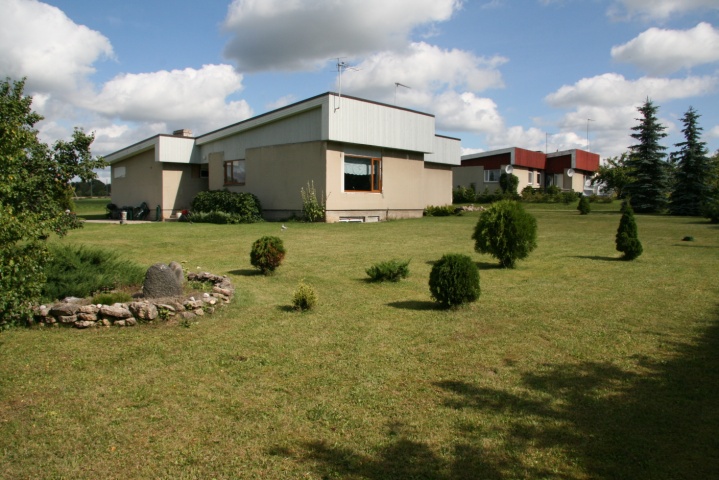 One family house Kullipesa (Hawk's nest), architect Tõnu Kull. Photo: Mart Kalm
One family house Kullipesa (Hawk's nest), architect Tõnu Kull. Photo: Mart Kalm
 One family house Kullipesa (Hawk's nest), 1974
One family house Kullipesa (Hawk's nest), 1974
The most popular among the one family houses, which were built in small quantities in each collective farm centre, was this design by architect Tõnu Kull who combined both traditional and modernist features. Of course the simple folk in the countryside preferred houses with pitched roof whereas the architects preferred the flat roof. This standard design was a kind of compromise – both were satisfied more or less, but of course in the case of a compromise nobody is satisfied. This house was called Kullipesa “Hawks nest”, “kulli” means “hawk” so this was some kind of inside joke. If you travel to different parts of Estonia you will see that the apartment blocks of collective farms are usually in ruins, because over the last twenty years the majority of the people from the countryside have migrated to cities, and there was no need for them anymore. But in the Kullipesa one family houses life still goes on or let’s say that the viable person who has found a job in the countryside, which is rather rare, has moved to these one family houses, which are more of a country style.
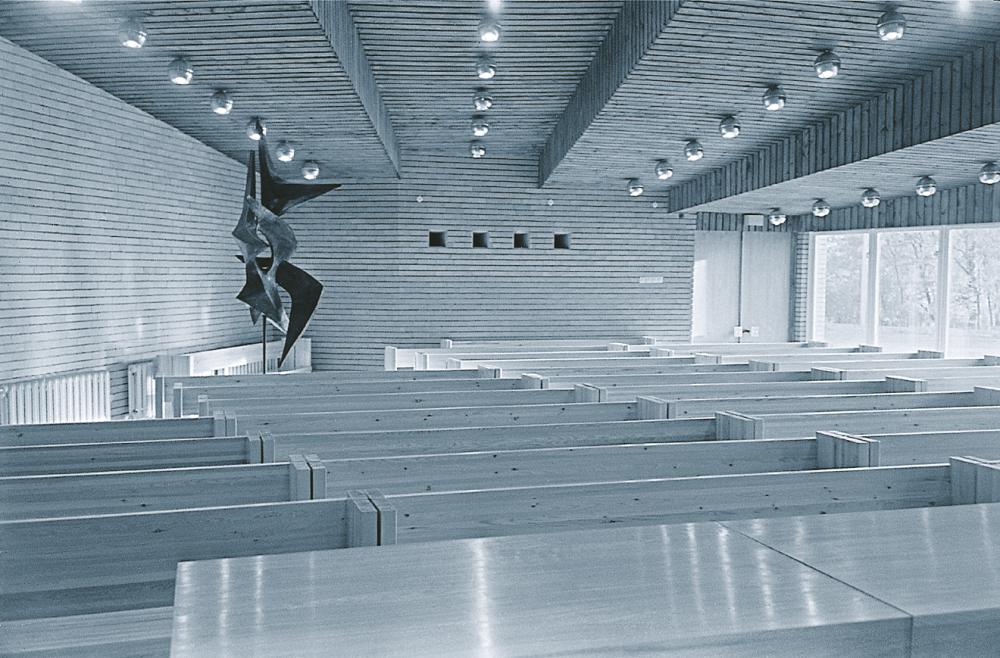 Interior of the administrative centre of the Kurtna Experimental Poultry Farm, architect Valve Pormeister, 1965 – 66
Interior of the administrative centre of the Kurtna Experimental Poultry Farm, architect Valve Pormeister, 1965 – 66
 Administrative centre of the Kurtna Experimental Poultry Farm. Photo: Mart Kalm
Administrative centre of the Kurtna Experimental Poultry Farm. Photo: Mart Kalm
The most important public buildings in the collective farm centres were the administrative centres, quite often with cultural centres. These were the first, let’s say, outstanding pieces of architecture. But of course here again there is a political story behind this. The Kurtna collective farm is rather close to Tallinn; it was built under the special patronage of the minister of agriculture who needed this building to show to the agricultural people who came from the rest of the Soviet Union. It was consciously built as a showcase. But of course, if you are the minister and you want to have a showcase this fact doesn’t guarantee you good architecture. But here he was lucky in that Valve Pormeister, a female architect of this postwar generation, accomplished it. We don’t need to go into details, but this was very Scandinavian and a lot of people back then in the mid-60s admired that. It’s almost like a piece of land from abroad and it still functions to this day. Of course, in 1991 all the collective farms in Estonia were dissolved very abruptly. The building was unused or disused for ten years and now it’s been renovated and changed into to a hotel. With it being close to Tallinn and having a rather beautiful hall, it’s a kind of proper place for weddings, parties and these kinds of things and functions. And also it is protected; it was given protective status before they started to renovate it, which is also one of the reasons why it was preserved.
 Põdrangu State farm Administrative and Culture Centre, near Tamsalu, architect Mara Metsal, 1977 – 82
Põdrangu State farm Administrative and Culture Centre, near Tamsalu, architect Mara Metsal, 1977 – 82
 Interior of the hall of the Põdrangu State farm Administrative and Culture Centre, sgrafitos Eva Jänes, 1977 – 82
Interior of the hall of the Põdrangu State farm Administrative and Culture Centre, sgrafitos Eva Jänes, 1977 – 82
The competition between the chairmen of kolkhozes was like that between the farmers earlier (“my barn must be bigger than yours” – “my cultural centre must be bigger than yours” etc.), which led to real exaggerations. For example all the walls of the building had sgrafitos – huge sgrafitos. Some would call it a blossom of Estonian art that those sgrafitos were made. But at the same time who really needed them there? Isn’t it kind of exaggeration, just a show off architecture? And of course as a piece of architecture it was not done so masterly.
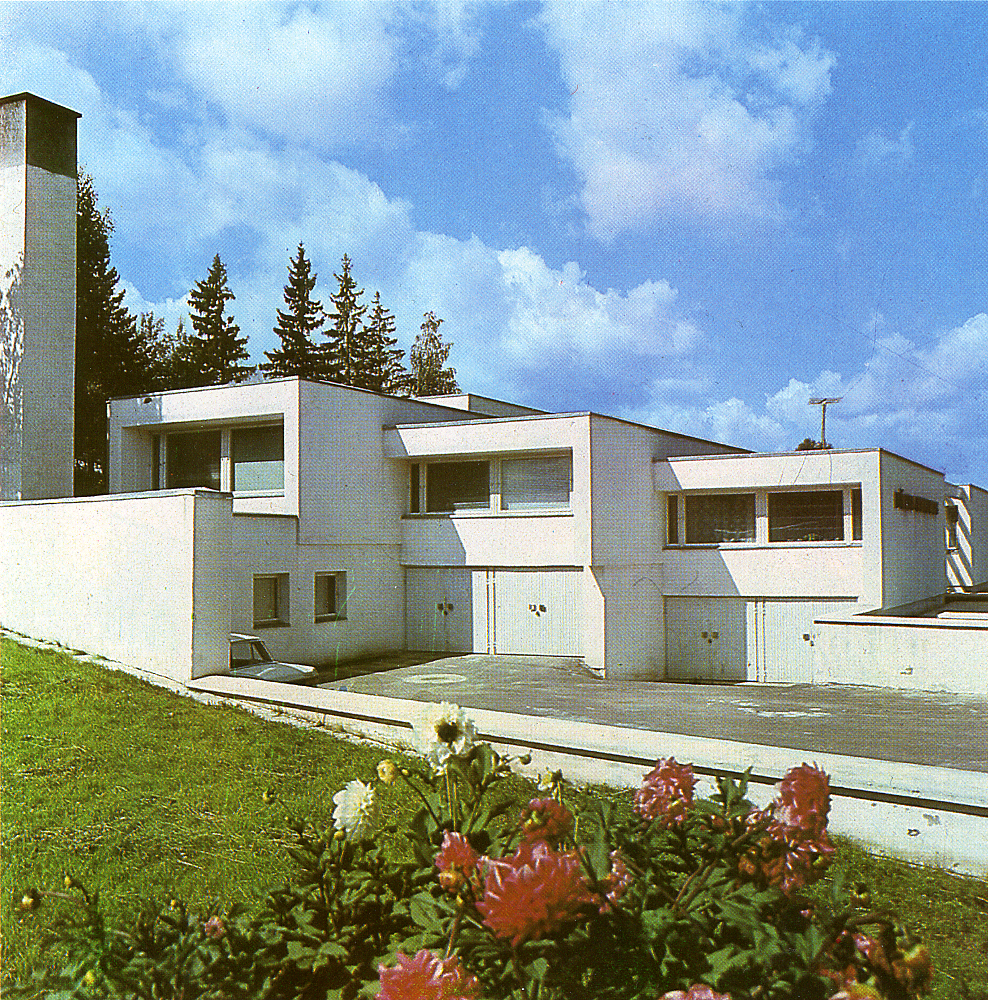 Põlva State farm Administrative Centre, architect Vilen Künnapu, 1972 – 74
Põlva State farm Administrative Centre, architect Vilen Künnapu, 1972 – 74
Another collective farm administrative centre was designed by Vilen Künnapu, who was the leader of Estonian avant-garde of the 70s and 80s. It still functions very well as a community house not being a cultural centre. It is interesting that a part of the hall is a copy of the Finnish Pavilion for the Brussels Expo ‘58 by Reima Pietilä. And it also worked as a standard design. In each collective farm centre there had to be a canteen and a shop, and the post office, and a hairdresser, and bus stop, and whatever but sometimes the architects were clever enough to use those chairmen who wanted to have powerful buildings, better than their neighbours’.
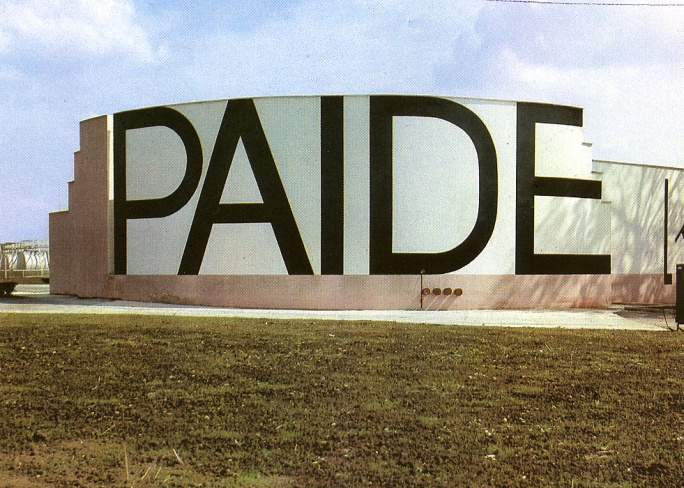 Paide KEK gas station, architect Jüri Okas, 1976 – 77
Paide KEK gas station, architect Jüri Okas, 1976 – 77
For example there was a very avant-garde gas station done by an architect and artist Jüri Okas. The original doesn’t exist anymore but it was rebuilt in the 90’s.
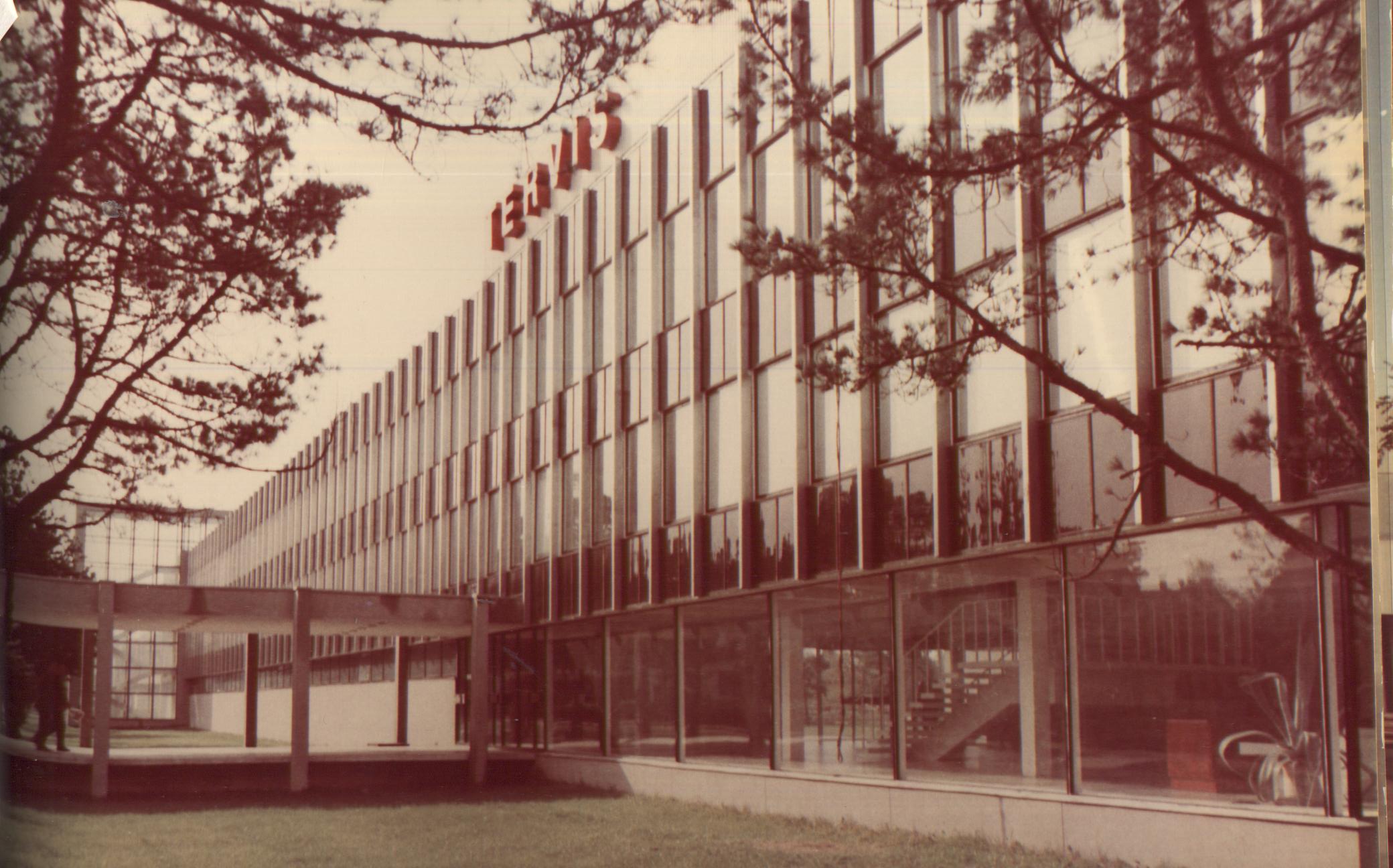 Inter-Kolhkoz sanatorium Tervis in Pärnu, architects Ell Väärtnõu, Kalju Vanaselja, 1971 – 76. Photo: Estonian Museum of Agriculture
Inter-Kolhkoz sanatorium Tervis in Pärnu, architects Ell Väärtnõu, Kalju Vanaselja, 1971 – 76. Photo: Estonian Museum of Agriculture
And one of the funniest things in my opinion has been this inter-collective farm sanatoria. They built three in total in Estonia. The first one was in Narva-Jõesuu and the second one in Pärnu. It’s typical of the 1950’s American international style of modernism started from Mies van der Rohe, Eero Saarinen has contributed to this (General Motors Centre), and Arne Jacobsen in Denmark has used the same idiom for the incredibly difficult to pronounce "Rodovre" community hall.
Straipsnis PDF formatu:
http://leidiniu.archfondas.lt/sites/default/files/15-28_lecture_mart%20kalm.pdf




